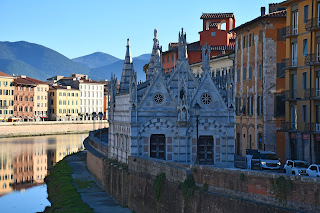Italy from South to North – Day 6: Pisa and Florence
Today was another early day, as we wanted to reach Pisa before crowds of other tourists descended upon the city. We woke up at seven o’clock, bought a quick breakfast, and caught the 7:54 train in the direction of Viareggio. I spent the whole ride reading about the city’s history. Pisa was an important city in the Middle Ages, competing with the neighbouring Florence and other trading powers like Venice and Genoa. In the war between the Guelphs and the Ghibellines, however, Pisa’s alliance with the emperor cost it dearly. As the Holy Roman Empire lost influence in Italy, Pisa’s competitors gained the upper hand, and the city’s glory days ended by the close of the thirteenth century.
Part of Pisa’s interesting
story can also be recounted through the biography of one of its most famous
inhabitants, the infamous Count Ugolino della Gherardesca. Though a Ghibelline,
Ugolino married into a family with Guelph ties, which led to his banishment
from Pisa. Supported by Charles I of Anjou, Ugolino fought his way back into
the city, forcing it to accept him and other exiles. As the newly minted captain
of a Pisan fleet division, he surrendered in a battle against the Genoese, and
as podestà he refused to make peace with Genoa for fear that doing so would
enable the return of other powerful exiles.
Nevertheless, Ugolino still
could have ruled happily had rising food prices not led to riots throughout
Pisa. During one such uprising, Ugolino killed a nephew of the archbishop, who
encouraged the populace to revolt against Ugolino and set fire to the town
hall. After Ugolino gave himself up, the archbishop declared himself podestà
and had Ugolino, his sons, and his grandsons immured in a Pisan tower and
starved to death. It is said that faced with this predicament, the count
eventually ate his progeny, but this is most likely not true.
Ugolino’s story is
recounted in the Divine Comedy by Dante, who comes across the count in the second
ring of the lowest circle of Hell. Trapped in ice, Ugolino is gnawing on the
head of Archbishop Ruggieri, both men punished for their treachery. Dante is
another figure whose biography illustrates the area’s rich and tumultuous
history. A native of Florence, Dante and his fellow citizens sided with the
Pope in the dispute between Guelphs and Ghibellines. However, the Guelphs soon began
infighting and split into two groups: the Black Guelphs (who continued to
support the Pope) and the White Guelphs (who asked for more autonomy).
A White Guelph, Dante
was sent to Rome as part of a diplomatic delegation. In his absence, however,
the Black Guelphs attacked his native Florence and took over the city. Having
murdered many of Dante’s allies, they seized Dante’s property, effectively
forcing the poet into exile. It was only then, banished from his home and the
world of politics, that Dante began to write the Divine Comedy. It is amazing
to think that this titan of world literature could have been killed before
producing his greatest work, and that he may never have written it had his
political hopes succeeded.
When we arrived in
Pisa, we headed immediately for the Piazza del Duomo, where we took pictures of
the lavish baptistry, the beautiful cathedral, and of course the famous leaning
Tower of Pisa. As the baptistry was closed, we only visited the cathedral and
climbed the leaning tower. With my fear of heights, I did not find it a very
pleasant experience. We then hurried back towards the train station and ate a
few heated slices of pizza, since there was still much to do in Florence.
In Florence, we first
visited the Basilica of Santa Maria Novella, which impressed me with its sheer
size and beautifully painted apse. We hoped to continue to the Cathedral of
Santa Maria del Fiore but encountered a long queue there and decided to
continue onwards instead. Stopping briefly by the Fountain of Neptune and the
Palazzo Vecchio, we walked over to the Basilica of Santa Croce. This grand
church – rising above an expansive Christmas market during the season of our
visit – contains the tombs of many famous Italians, including the composer
Gioachino Rossini, the artist Michelangelo Buonarotti, the historian Leonardo
Bruni, and the astronomer Galileo Galilei. It also features the artworks of
Giotto and Donatello, among others.
There was still a
little time to kill before our timed entry to the Gallery of Uffizi, so we made
a loop around Florence’s Old Bridge by crossing over the Ponte alle Grazie and
back again using the Ponte Santa Trinità. Finally, at 15:30, we entered Uffizi,
a gallery that began as a private collection belonging to the Medici and has
since expanded to one of the most significant museums in the world. As
expected, it was huge. We did not attempt to study every artwork, nor would
have there been enough time to do so. However, there were many pieces that
stood out to me.
One cannot visit
Uffizi without seeing Botticelli’s Birth of Venus, Titian’s Venus of Urbino, or
Caravaggio’s Medusa. However, I also found myself marvelling at some of the
lesser-known works, such as Caravaggio’s Sacrifice of Isaac, which depicts
Isaac’s pain and terror with unsettling realism. After we left Uffizi, we ate
an early dinner at a restaurant in the city. I had some kind of flat pasta in
tomato sauce, and Aron and I shared a tiramisu for dessert.






























































Comments
Post a Comment